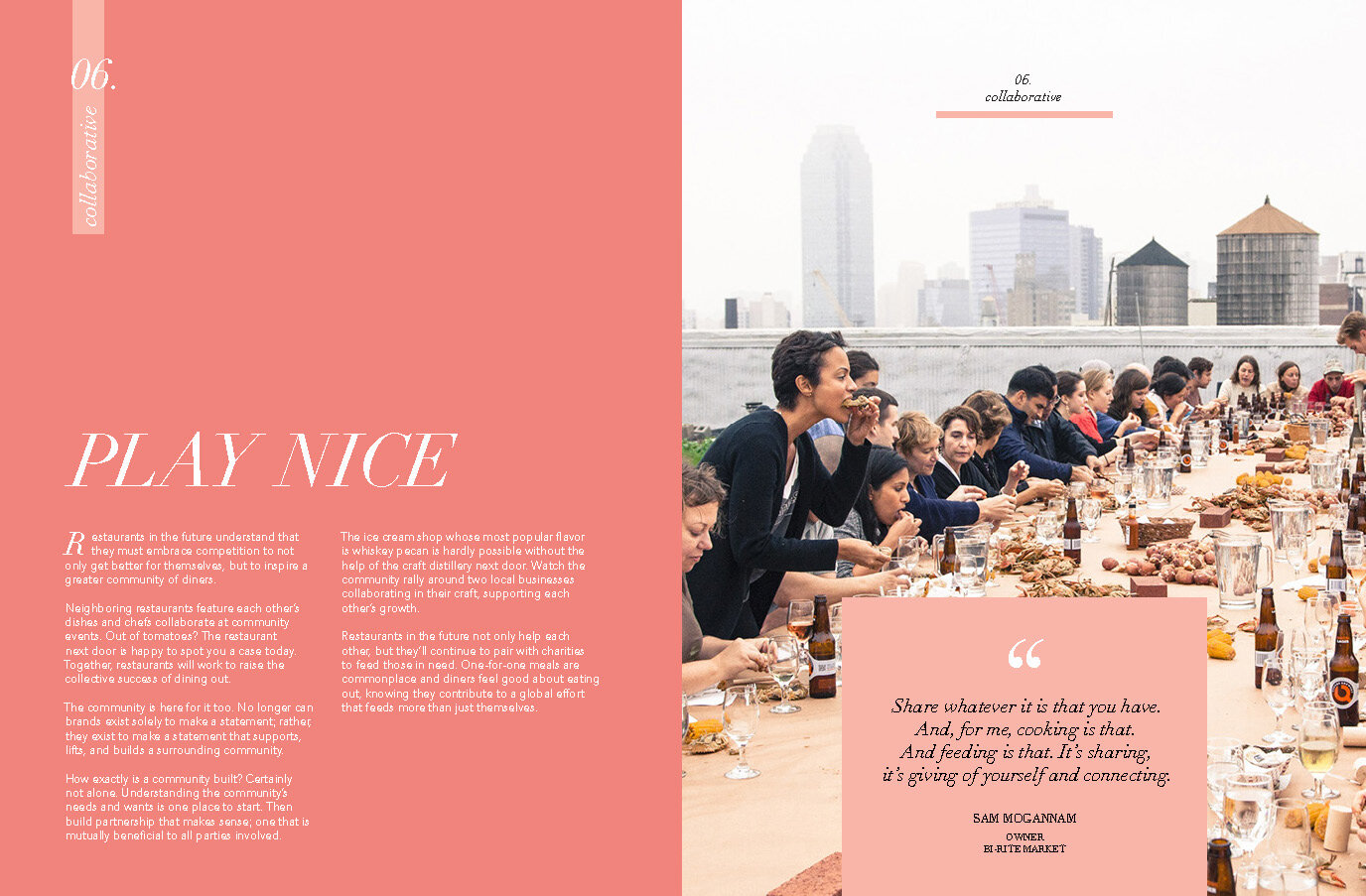
Restaurant of the Future

STANDING OUT IN THE RESTAURANT INDUSTRY
Uncovering design principles that help restaurants succeed in the evolving landscape.
CHALLENGE
Form a perspective about the restaurant of the future that inspires restaurant operators to incorporate design principles from other successful restaurants into their own.
OUTCOME
A coffee table book to share with Gordon Food Service partners and customers
A touring Relish-hosted panel series
Videos for easy sharing
IMPACT
The book and other assets established Relish Works as a thought leader in two ways. We made connections with the tight-knit Chicago restaurant industry, getting operators interested in helping with future projects, and demonstrated the value in design thinking for the restaurant industry.
INTRODUCTION
Brick-and-mortar businesses have been on a steady decline over the past decade, with the exception of one: restaurants. The National Restaurant Association reported annual sales of $799 billion—close to 48% of the total amount that Americans spent on food in 2017. Those astounding numbers have a side effect: a wildly competitive industry where brands flock to the restaurant industry.
Those that thrive have a keen awareness of millennial-inspired, tech-infused dining trends, and how to serve an audience with access to endless information. While many art forms can be downloaded instantly, from music to film, food is the last piece of culture that can’t be downloaded. You can’t truly experience it, no matter how well-curated the Instagram post is.
Restaurants remain a focal point of culture as a place of genuine connection, where experiences are fostered, stories are told, and communities are built. Those that adapt their service models to the world outside their own kitchens will be met with insatiable appetites.
Research
To get a picture of the restaurant of the future, we looked at what today’s businesses are doing to stand out from the crowd. Not limiting ourselves to just the restaurant world, we took inspiration from the hospitality, retail and entertainment industries.
We started with exploratory and inspirational research online to identify where to concentrate our primary research effort. New York City was a clear contender for new and innovative experiences, but we also wanted to see how a less cosmopolitan location would differ. We chose Lexington, Kentucky and its surrounding areas. We covertly conducted interviews and asked questions as curious consumers in order to get the true experience. Applying our design research lens to these experiences helped us understand some of the decisions and strategies these businesses made.
The SKIFT Restaurant Forum coincided with our primary research week in NYC. We had the opportunity to hear from restaurant heavyweights like Stephanie Izard and BOKA Group, Russ and Daughters, and third party delivery party, Seamless, on how they are adapting in the changing industry.
Take a peek at our Instagram documentation @relishtastes.
Analysis
Through our research, we identified six distinct design principles by synthesizing all of our real life experiences and internet exploring . The beauty of these principles is that any restaurant could incorporate them, regardless of the food they cook, where they are in the world, or how fancy or casual they are.
Connected- learn, know, and predict what diners want
Experiential - create a story worth telling
Intentional - design an authentic brand personality
Accessible- serve all audiences
Multi use - house many things under one roof
Collaborative - build community and honest partnerships
We also created and facilitated a workshop on what an ideal restaurant of the future would be for GFS and Relish, coming up with some wacky, inventive, and creative ideas.
Design
Not only did we want an informative way to share our perspective with GFS employees, customers, and partners, we also imagined a book worthy of sitting on coffee tables (that weren’t just our own.) The highly visual, magazine style book introduces the overall narrative and the following chapters do a dive deep into each design principle. Vignettes show how each featured restaurant, business, or brand exemplifies an aspect of that chapter’s principle and case studies feature our unique, first-hand experiences.
After highlighting what today’s restaurants are doing, we imagined what breakfast, lunch, and dinner could look like in 2029 using the same design principles. The end of the book pushes readers to consider a changed world where restaurants as we know them have evolved to meet new needs or even created previously unknown services and offerings.
For easier sharing, we turned the book into a video. It was a quick way to introduce the book before panels or events, but also a chance to bring some of our favorite stories to life.





























